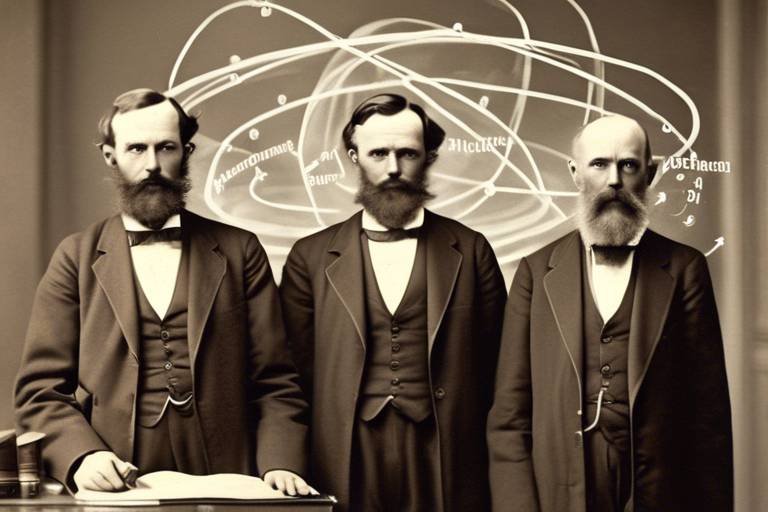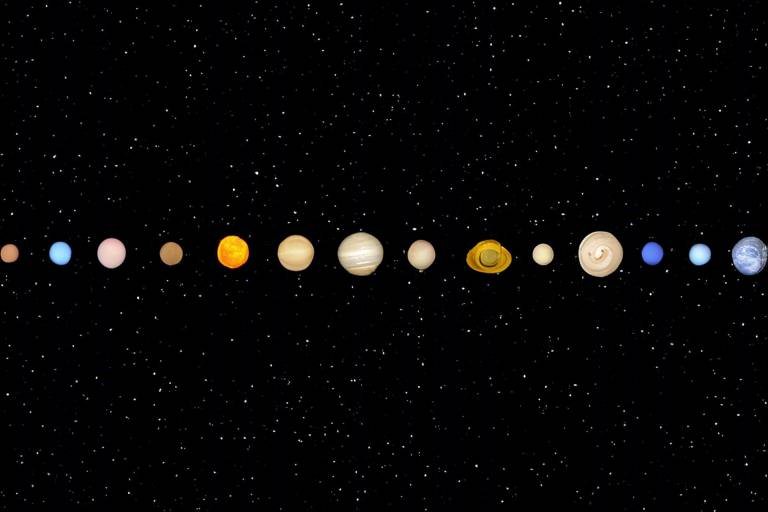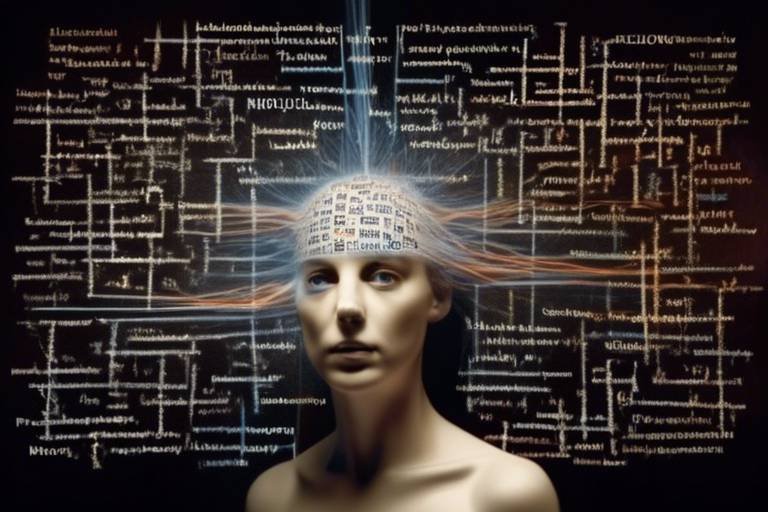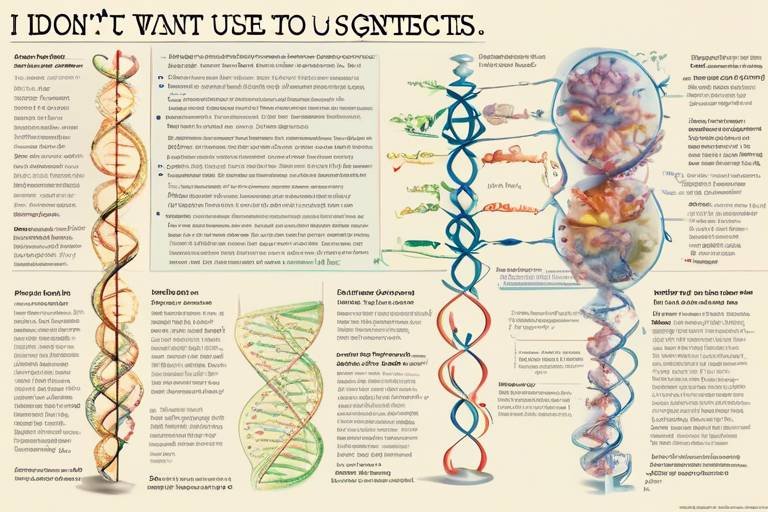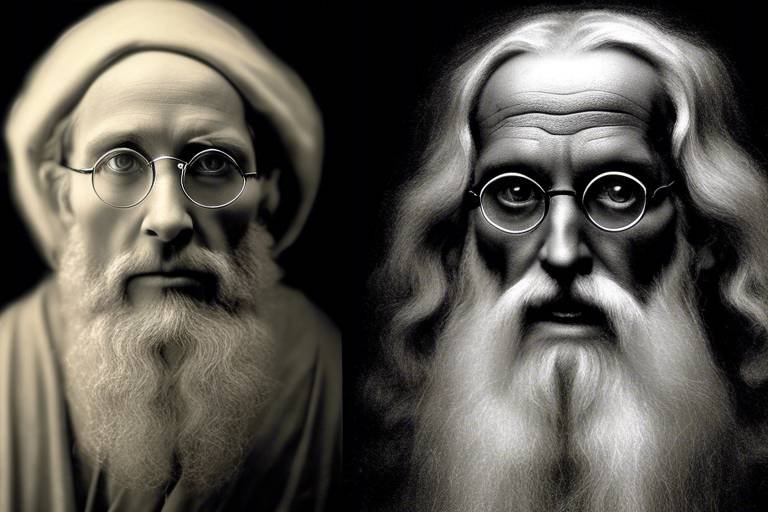From Atomism to Atomic Theory - The Philosophy behind Science
The journey from the ancient concept of atomism to the modern atomic theory we understand today is nothing short of fascinating. It’s a story that intertwines philosophy, science, and curiosity, showcasing how human thought has evolved over millennia. Imagine standing at the precipice of knowledge, gazing into the unknown, where tiny particles are the building blocks of everything around us—this is where our story begins.
In ancient times, thinkers like Democritus and Leucippus proposed that everything in the universe is made up of tiny, indivisible particles called atoms. They envisioned a world composed of these minuscule entities, which, while invisible to the naked eye, were believed to be the essence of all matter. Their ideas were revolutionary, laying the groundwork for what would become a pivotal aspect of scientific inquiry. However, it would take centuries of philosophical debate and scientific exploration to refine these ideas into the robust atomic theory we recognize today.
As we delve deeper into the evolution of atomic theory, we encounter key figures who played significant roles in shaping our understanding. Think of them as the architects of modern science, each contributing unique insights that built upon the foundations laid by their predecessors. Among them, John Dalton, J.J. Thomson, and Ernest Rutherford stand out as pivotal contributors. Their discoveries not only advanced the atomic model but also challenged existing beliefs, propelling science into new realms of discovery.
Dalton’s atomic theory, for instance, introduced the idea of atoms as solid, indivisible spheres. This was a radical departure from previous notions and set the stage for future explorations into the intricate structure of matter. Imagine a world where everything is made from these tiny spheres, bouncing around and combining in various ways—this was the essence of Dalton's vision. Yet, as we would later discover, Dalton's model had its limitations, particularly in accounting for the complexities of subatomic particles and isotopes.
As we continue our exploration, we must acknowledge the monumental discovery of the electron by J.J. Thomson. His experiments shattered the notion of indivisible atoms, revealing a more complex atomic structure. Picture this: a tiny, negatively charged particle whizzing around a central nucleus, fundamentally changing our understanding of atomic behavior. This discovery was akin to opening a door to a new dimension, where the rules of the game were entirely different.
Next, we turn our attention to Ernest Rutherford and his groundbreaking gold foil experiment. This pivotal moment in scientific history unveiled the nuclear structure of the atom. Through his experiments, Rutherford discovered that atoms are mostly empty space, with a dense nucleus at their center. This revelation led to the development of the planetary model of the atom, where electrons orbit the nucleus much like planets around the sun. It was a profound shift in our understanding, illustrating that the atomic world was far more intricate than previously imagined.
The implications of these advancements extend far beyond the realm of chemistry and physics. They have influenced various scientific fields, including medicine, where understanding atomic structure is crucial for developing new technologies and treatments. The evolution of atomic theory has not only shaped our comprehension of the material world but has also paved the way for innovations that have transformed society.
- What is atomism?
Atomism is the philosophical belief that everything in the universe is composed of small, indivisible particles called atoms.
- Who were the key contributors to atomic theory?
Key figures include Democritus, John Dalton, J.J. Thomson, and Ernest Rutherford, each of whom made significant contributions to our understanding of atomic structure.
- What was Dalton's atomic theory?
Dalton's atomic theory proposed that atoms are solid, indivisible spheres that combine in fixed ratios to form compounds.
- How did J.J. Thomson change our understanding of atoms?
Thomson discovered the electron, demonstrating that atoms are not indivisible and contain smaller subatomic particles.
- What is the significance of Rutherford's gold foil experiment?
Rutherford's experiment revealed the nuclear structure of the atom, leading to the planetary model where electrons orbit a dense nucleus.

The Origins of Atomism
The concept of atomism traces its roots back to ancient Greece, where the seeds of modern science were sown by brilliant thinkers. Among these pioneers, Democritus and Leucippus stand out as the primary architects of the idea that everything in the universe is made up of tiny, indivisible particles called atoms. Imagine a world where everything around you, from the air you breathe to the chair you sit on, is composed of these minute building blocks. It’s a mind-boggling thought, but it was this very idea that laid the groundwork for centuries of scientific exploration and discovery.
Democritus, often referred to as the 'laughing philosopher' due to his cheerful demeanor, proposed that these atoms were eternal, unchangeable, and varied in shape and size. He believed that the differences in matter were due to the arrangement and motion of these atoms. His vision was not just a scientific hypothesis but a philosophical stance that questioned the very nature of reality. Leucippus, his mentor, also contributed to this early atomic theory, suggesting that the universe was composed of a void and these atoms, which moved freely through it.
While their ideas were revolutionary, they faced significant skepticism from their contemporaries. The prevailing philosophical thought at the time, dominated by figures like Aristotle, rejected the notion of empty space and indivisible particles. Aristotle argued that matter was continuous and could be divided infinitely without ever reaching a fundamental unit. This debate between atomism and continuous matter would persist for centuries, influencing the trajectory of scientific thought.
Fast forward to the Renaissance, when a revival of interest in ancient texts reignited discussions about atomism. The emergence of the scientific method and advancements in technology provided a fresh perspective on these age-old theories. Scientists began to conduct experiments that would either validate or challenge the ideas of Democritus and Leucippus. This period marked a significant turning point, as the philosophical foundations of atomism began to intertwine with empirical evidence.
In summary, the origins of atomism are deeply rooted in ancient philosophy, where thinkers like Democritus and Leucippus dared to propose that matter is composed of tiny, indivisible particles. Their groundbreaking ideas, although initially met with resistance, paved the way for future scientific inquiry. The transition from philosophical speculation to scientific exploration set the stage for the development of atomic theory, which continues to evolve today.

Key Philosophical Contributors
The journey of atomic theory is not just a tale of scientific discovery; it's a rich tapestry woven with the threads of philosophical inquiry and intellectual curiosity. From the ancient musings of philosophers to the rigorous experimentation of modern scientists, the evolution of atomic theory has been profoundly shaped by key figures whose ideas paved the way for our current understanding of matter. Among these trailblazers are John Dalton, J.J. Thomson, and Ernest Rutherford, each contributing unique insights that transformed the scientific landscape.
Let’s start with John Dalton, a name synonymous with the birth of modern atomic theory. In the early 19th century, Dalton proposed that all matter is composed of tiny, indivisible particles called atoms. His revolutionary idea was not just a scientific hypothesis; it was a philosophical leap that challenged the existing notions of matter. Dalton's atomic theory was built on several postulates, including the idea that atoms of a given element are identical and that they combine in simple whole-number ratios to form compounds. This framework laid the groundwork for future explorations into atomic structure and behavior.
Next, we encounter the brilliant mind of J.J. Thomson, who, in the late 19th century, turned the atomic world upside down with his discovery of the electron. Thomson’s experiments with cathode rays revealed that atoms were not indivisible after all; they contained smaller particles. This finding sparked a revolution in atomic theory, leading to the realization that the atom is a complex structure made up of even tinier components. Thomson's work not only challenged Dalton's model but also opened the door to a new understanding of atomic interactions and electricity.
Then, we have Ernest Rutherford, whose groundbreaking gold foil experiment in 1909 provided further clarity on the atomic structure. By bombarding a thin sheet of gold with alpha particles, Rutherford observed that most passed through, but some were deflected at sharp angles. This unexpected result led him to propose the existence of a dense, positively charged nucleus at the center of the atom, surrounded by orbiting electrons. Rutherford's model, often referred to as the planetary model, fundamentally changed how scientists viewed atomic structure, illustrating that atoms were not just solid spheres but complex systems with distinct regions.
To summarize the contributions of these key figures, consider the following table:
| Contributor | Key Contribution | Impact on Atomic Theory |
|---|---|---|
| John Dalton | Proposed the concept of indivisible atoms | Laid the foundation for modern atomic theory |
| J.J. Thomson | Discovered the electron | Revolutionized the understanding of atomic structure |
| Ernest Rutherford | Revealed the nuclear structure of the atom | Paved the way for the planetary model of the atom |
These contributors not only advanced scientific knowledge but also sparked philosophical debates about the nature of reality and the fundamental building blocks of the universe. Their ideas and discoveries remind us that science is not merely a collection of facts; it is a dynamic interplay of thought, inquiry, and discovery that continues to evolve as we seek to understand the world around us.
- What is atomic theory?
Atomic theory is a scientific theory that states that matter is composed of discrete units called atoms, which are the fundamental building blocks of all substances.
- Who first proposed the idea of atoms?
The concept of atoms was first proposed by ancient Greek philosophers, notably Democritus and Leucippus, who suggested that everything is made up of indivisible particles.
- How did Dalton contribute to atomic theory?
John Dalton formulated the first modern atomic theory, proposing that atoms are indivisible and that they combine in fixed ratios to form compounds.
- What was J.J. Thomson's major discovery?
J.J. Thomson discovered the electron, demonstrating that atoms are not indivisible but contain smaller particles.
- What did Rutherford's gold foil experiment reveal?
Rutherford's experiment revealed the existence of a small, dense nucleus within the atom, leading to the development of the planetary model of atomic structure.

The Dalton Model
John Dalton's atomic theory, proposed in the early 19th century, marked a significant turning point in the understanding of matter. Before Dalton, the idea of atoms was largely philosophical, with little empirical evidence to support their existence. Dalton, however, transformed this abstract notion into a scientific framework by introducing the concept of atoms as solid, indivisible spheres. He believed that these tiny particles were the fundamental building blocks of all matter, much like how LEGO bricks can be combined in various ways to create different structures.
Dalton's model was revolutionary because it provided a systematic way to explain chemical reactions. He proposed that each element is composed of its own unique type of atom, and that atoms of different elements can combine in fixed ratios to form compounds. This idea led to the formulation of the Law of Multiple Proportions, which states that when two elements combine, they do so in ratios of small whole numbers. For example, when carbon and oxygen combine to form carbon dioxide (CO2) or carbon monoxide (CO), the ratio of carbon to oxygen in these compounds is always a simple whole number.
To illustrate this concept, consider the following table that summarizes Dalton's key postulates:
| Postulate | Description |
|---|---|
| 1 | All matter is composed of indivisible atoms. |
| 2 | Atoms of the same element are identical in mass and properties. |
| 3 | Atoms of different elements differ in mass and properties. |
| 4 | Atoms combine in simple whole-number ratios to form compounds. |
| 5 | Atoms cannot be created or destroyed in a chemical reaction. |
While Dalton's atomic model was groundbreaking, it wasn't without its flaws. One major limitation was that it treated atoms as indivisible, failing to account for the existence of subatomic particles such as electrons, protons, and neutrons, which were discovered later. This oversight led to further refinements in atomic theory, as scientists began to understand that atoms were, in fact, complex structures made up of even smaller components.
In summary, Dalton's model laid the groundwork for modern atomic theory, providing a clear and concise framework for understanding the composition of matter. His ideas not only advanced the field of chemistry but also sparked a wave of research that would eventually lead to the discovery of the subatomic world. So, the next time you think about the building blocks of matter, remember that Dalton's vision was the first step in a long journey of scientific exploration.
- What was John Dalton's main contribution to atomic theory? Dalton's main contribution was the introduction of the concept of atoms as solid, indivisible spheres and the formulation of the Law of Multiple Proportions.
- How did Dalton's model change our understanding of matter? Dalton's model provided a scientific basis for the existence of atoms and explained how they combine to form compounds, paving the way for modern chemistry.
- What are some limitations of Dalton's atomic theory? Dalton's theory did not account for subatomic particles or isotopes, which were discovered later, indicating that atoms are not indivisible.

The Law of Multiple Proportions
The Law of Multiple Proportions is one of those pivotal concepts in chemistry that not only solidified the existence of atoms but also showcased the beauty of how elements combine. Proposed by John Dalton in the early 19th century, this law states that when two elements combine to form more than one compound, the masses of one element that combine with a fixed mass of the other are in the ratio of small whole numbers. This might sound a bit technical, but let’s break it down with an analogy: imagine you’re baking cookies. If you decide to use different amounts of chocolate chips with a fixed amount of flour, the ratios of chocolate chips to flour can vary, but they will always simplify to whole numbers, like 1:2 or 2:3. Similarly, the law illustrates how elements interact in a predictable and quantifiable manner.
To visualize the Law of Multiple Proportions, let's consider the example of carbon and oxygen. These two elements can form two distinct compounds: carbon monoxide (CO) and carbon dioxide (CO2). If we take a fixed amount of carbon (say 12 grams), we can see how the oxygen combines in different ratios:
| Compound | Mass of Oxygen (g) | Ratio of Oxygen to Carbon |
|---|---|---|
| Carbon Monoxide (CO) | 16 | 1:1 |
| Carbon Dioxide (CO2) | 32 | 2:1 |
This table illustrates how, with a fixed mass of carbon, the mass of oxygen changes in a simple ratio, reinforcing the idea that elements combine in whole number ratios. It’s like a dance where each element knows its steps, moving smoothly in harmony with the others.
However, it’s crucial to note that the Law of Multiple Proportions was not just a standalone concept; it was part of a larger framework that included Dalton’s atomic theory. This law provided the empirical evidence that supported the idea of atoms as fundamental building blocks of matter. It helped chemists understand that while elements can combine in various ways, those combinations can be predicted and quantified, much like how different recipes yield different dishes but follow a consistent method.
In summary, the Law of Multiple Proportions is a cornerstone of modern chemistry, illustrating the orderly nature of chemical combinations. It not only validates Dalton's atomic theory but also serves as a reminder of the elegance and predictability of the natural world. Understanding this law not only deepens our appreciation for chemistry but also opens the door to exploring more complex interactions between elements.
- What is the Law of Multiple Proportions?
The Law of Multiple Proportions states that when two elements combine to form more than one compound, the masses of one element that combine with a fixed mass of the other are in the ratio of small whole numbers. - Who proposed the Law of Multiple Proportions?
This law was proposed by John Dalton in the early 19th century as part of his atomic theory. - Can you give an example of the Law of Multiple Proportions?
Yes! A common example involves carbon and oxygen forming carbon monoxide (CO) and carbon dioxide (CO2). The ratios of oxygen that combine with a fixed mass of carbon are in whole numbers.

Limitations of Dalton's Theory
While John Dalton's atomic theory was revolutionary for its time, introducing the concept of atoms as solid, indivisible spheres, it was not without its limitations. One of the most significant drawbacks was its failure to account for the existence of subatomic particles. Dalton proposed that atoms were the smallest units of matter, but this notion was soon challenged by discoveries that revealed a more complex structure within atoms. For instance, the discovery of electrons by J.J. Thomson in 1897 shattered the idea of the atom as indivisible, showing that atoms were, in fact, composed of even smaller particles.
Moreover, Dalton's theory did not incorporate the existence of isotopes—atoms of the same element that have different numbers of neutrons. This oversight meant that Dalton's model could not explain variations in atomic mass that were later observed. The concept of isotopes has become fundamental in fields like chemistry and nuclear physics, where understanding the differences in atomic structure is crucial for various applications, from radiocarbon dating to medical imaging.
Another limitation of Dalton's atomic model was its inability to explain the behavior of gases and the principles of chemical bonding adequately. Dalton's theory suggested that atoms combined in simple whole-number ratios, which is true to some extent, but it failed to address the complexities of molecular structures and the interactions between different types of atoms. In reality, chemical reactions involve a much more intricate interplay of forces, including electromagnetic interactions that Dalton's model could not encapsulate.
To summarize, while Dalton's atomic theory laid the groundwork for modern chemistry, it was limited by its simplistic view of atomic structure and behavior. The subsequent discoveries of subatomic particles, isotopes, and the complexities of chemical bonding have led to more sophisticated models that continue to evolve. Understanding these limitations not only enriches our historical perspective on atomic theory but also highlights the importance of questioning and refining scientific ideas as new evidence emerges.
- What was John Dalton's main contribution to atomic theory? Dalton's main contribution was the introduction of the idea that matter is composed of atoms, which are indivisible particles that combine in fixed ratios to form compounds.
- Why was Dalton's theory considered limited? Dalton's theory was limited because it did not account for the existence of subatomic particles like electrons, nor did it consider isotopes or the complexities of chemical bonding.
- How did the discovery of electrons challenge Dalton's theory? The discovery of electrons showed that atoms are not indivisible; rather, they are made up of smaller particles, which contradicted Dalton's original assertion.
- What advancements followed Dalton's atomic theory? Following Dalton, advancements included the discovery of the nucleus by Ernest Rutherford and the development of quantum mechanics, which provided a deeper understanding of atomic structure.

The Discovery of Electrons
The journey to uncover the existence of electrons is nothing short of fascinating, marking a pivotal moment in the evolution of atomic theory. In the late 19th century, scientists were eager to understand the fundamental components of matter, and this curiosity led to groundbreaking experiments. One of the key figures in this quest was J.J. Thomson, whose innovative work with cathode rays in 1897 forever changed our understanding of the atom.
Thomson's experiments involved passing electric currents through gases at low pressure. When he applied a high voltage to a cathode, he observed a stream of particles being emitted from the cathode. These particles, which he initially called "corpuscles," were later identified as electrons. Thomson's discovery was revolutionary because it challenged the long-held belief that atoms were indivisible. Instead, he proposed that atoms were made up of smaller, charged particles.
To illustrate the significance of this discovery, consider the analogy of a fruit salad. Just as a fruit salad consists of various fruits, each contributing to the overall flavor and texture, atoms are composed of different particles, including electrons, protons, and neutrons. This realization opened the door to a new understanding of atomic structure and paved the way for further exploration into the nature of matter.
Thomson's work led to the development of the plum pudding model of the atom, where electrons were thought to be embedded within a positively charged "soup." However, this model was soon challenged by subsequent discoveries, particularly those from fellow scientist Ernest Rutherford, who conducted experiments that revealed the nucleus of the atom. Nevertheless, Thomson's identification of the electron was a crucial step in the journey of atomic theory.
To better appreciate the impact of Thomson's discovery, let's take a look at a brief timeline of key events leading to the identification of the electron:
| Year | Event |
|---|---|
| 1897 | J.J. Thomson discovers the electron through cathode ray experiments. |
| 1904 | Thomson proposes the plum pudding model of the atom. |
| 1911 | Ernest Rutherford conducts the gold foil experiment, leading to the nuclear model of the atom. |
Thomson's discovery of the electron not only reshaped atomic theory but also had profound implications across various scientific fields. It laid the groundwork for advancements in chemistry, physics, and even technology. The existence of electrons allowed scientists to explore the nature of chemical bonds, electricity, and the behavior of materials at the atomic level. As we delve deeper into the atomic structure, we realize that understanding electrons is crucial for grasping the complexities of the universe.
In conclusion, the discovery of electrons by J.J. Thomson was a groundbreaking moment that transformed our perception of matter. It challenged existing beliefs and opened up new avenues of research that continue to influence science today. As we stand on the shoulders of giants like Thomson, we can appreciate the intricate dance of particles that make up everything around us.
- What are electrons? Electrons are subatomic particles with a negative charge that orbit the nucleus of an atom.
- Why was the discovery of electrons important? The discovery of electrons changed the understanding of atomic structure and led to the development of modern physics and chemistry.
- Who discovered the electron? The electron was discovered by J.J. Thomson in 1897 through experiments with cathode rays.

The Rutherford Model of the Atom
The Rutherford model of the atom emerged from one of the most iconic experiments in the history of science—the gold foil experiment. Conducted in 1909, this groundbreaking experiment was designed to probe the structure of the atom by firing alpha particles at a thin sheet of gold. What Rutherford and his team discovered was nothing short of revolutionary. Instead of passing through the gold foil as expected, some alpha particles were deflected at large angles, while a few even bounced back toward the source. This unexpected behavior led Rutherford to propose a radical new model of atomic structure, fundamentally altering our understanding of matter.
Rutherford's findings suggested that atoms are not solid spheres, as previously thought, but rather consist of a small, dense nucleus surrounded by a cloud of electrons. This nucleus, which contains most of the atom's mass, is positively charged due to the presence of protons. The electrons, on the other hand, orbit this nucleus at varying distances, much like planets orbiting the sun. This planetary model of the atom was a significant leap forward in atomic theory, providing a clearer picture of atomic structure that paved the way for future discoveries.
One of the most significant implications of the Rutherford model was the introduction of the concept of the nucleus. The nucleus is a tiny, dense core at the center of the atom, and it contains protons and neutrons. This discovery was monumental because it shifted the focus of atomic theory from the idea of indivisible particles to a more complex structure that included subatomic particles. The table below summarizes the key components of the Rutherford model:
| Component | Description |
|---|---|
| Nucleus | Dense center of the atom containing protons and neutrons. |
| Electrons | Negatively charged particles that orbit the nucleus. |
| Protons | Positively charged particles found in the nucleus. |
| Neutrons | Neutral particles found in the nucleus. |
Rutherford's model also opened doors to the field of nuclear physics, leading to further research into atomic behavior and the forces that hold the nucleus together. The discovery of the nucleus and the arrangement of electrons around it laid the groundwork for the Bohr model, which would later refine our understanding of electron orbits and energy levels. But even with these advancements, the Rutherford model had its limitations. For instance, it could not explain why electrons, which are charged, do not spiral into the nucleus due to electromagnetic attraction. This paradox prompted further inquiries and refinements in atomic theory.
In conclusion, the Rutherford model of the atom was a pivotal moment in the history of science. It not only challenged existing beliefs about atomic structure but also set the stage for future discoveries in chemistry and physics. By revealing the complexity of the atom, Rutherford’s work ignited a series of explorations that would ultimately lead to our modern understanding of atomic and subatomic particles.
- What was the main finding of Rutherford's gold foil experiment?
Rutherford discovered that atoms have a small, dense nucleus at their center, which contains protons and neutrons, while electrons orbit around this nucleus. - How did the Rutherford model differ from earlier atomic models?
Prior models depicted atoms as solid spheres; the Rutherford model introduced the concept of a nucleus and electron orbits, providing a more complex understanding of atomic structure. - What were the limitations of the Rutherford model?
The Rutherford model could not explain the stability of electron orbits and the emission of radiation, which led to further developments in atomic theory, particularly the Bohr model.

The Concept of the Nucleus
The concept of the nucleus is one of the most significant breakthroughs in the understanding of atomic structure, and it all began with Ernest Rutherford's famous gold foil experiment in 1909. Before this groundbreaking work, the prevailing atomic model was largely based on John Dalton's ideas, which depicted atoms as solid, indivisible spheres. However, Rutherford's experiment revealed a much more complex reality. By bombarding a thin sheet of gold with alpha particles, he observed that while most particles passed through, a small fraction were deflected at large angles. This observation led him to propose that atoms consist of a tiny, dense center called the nucleus, surrounded by a cloud of electrons.
The nucleus is crucial for several reasons. First, it contains the majority of an atom's mass, which is surprising considering its minuscule size relative to the entire atom. To illustrate this, consider the following table that compares the sizes of the nucleus and the overall atom:
| Component | Size (approx.) |
|---|---|
| Nucleus | 10^-15 meters |
| Atom | 10^-10 meters |
This stark difference in size illustrates how the nucleus, though incredibly small, plays a pivotal role in determining the properties of an element. The nucleus is composed of protons and neutrons, collectively known as nucleons. The number of protons in the nucleus defines the element itself, while the number of neutrons can vary, leading to different isotopes of the same element. This fundamental understanding of atomic structure has vast implications for various fields, including chemistry and physics.
Rutherford's findings not only reshaped our view of the atom but also laid the groundwork for future research into nuclear physics. The nucleus's existence prompted questions about the forces that hold it together, leading to the discovery of the strong nuclear force and ultimately the development of quantum mechanics. Furthermore, this understanding has profound implications in fields such as medicine, particularly in the development of radiation therapy for cancer treatment, where the behavior of atomic nuclei is crucial.
In summary, the concept of the nucleus transformed our understanding of matter at its most fundamental level. It highlights the intricate balance of forces that govern atomic structure and behavior, serving as a cornerstone for modern scientific inquiry. As we continue to explore the mysteries of the universe, the nucleus remains a focal point, bridging the gap between the microscopic world of atoms and the macroscopic phenomena we observe every day.
- What is the nucleus made of? The nucleus is primarily composed of protons and neutrons, which are collectively known as nucleons.
- Why is the nucleus important? The nucleus contains most of an atom's mass and determines the chemical properties of an element based on the number of protons it has.
- How did Rutherford discover the nucleus? Rutherford discovered the nucleus through his gold foil experiment, where he observed the deflection of alpha particles, indicating the presence of a dense center within the atom.
- What role does the nucleus play in nuclear reactions? The nucleus is central to nuclear reactions, as changes in the number of protons and neutrons can lead to the release of energy, as seen in nuclear fission and fusion.

Implications for Modern Science
The journey from ancient atomism to contemporary atomic theory has profoundly impacted various scientific fields, reshaping our understanding of the universe and the matter within it. The evolution of atomic theory has not only enhanced our grasp of chemical reactions but has also paved the way for groundbreaking advancements in physics and medicine. Imagine a world where we can manipulate matter at the atomic level; this is not just a dream but a reality shaped by centuries of scientific inquiry.
One of the most significant implications of atomic theory is its influence on chemistry. The understanding of atoms as the fundamental building blocks of matter has led to the development of the periodic table, a tool that organizes elements based on their atomic structure and properties. This organization has enabled chemists to predict how different elements will interact, leading to the creation of new compounds and materials. For instance, the synthesis of new drugs relies heavily on our knowledge of atomic interactions, showcasing how atomic theory is intricately linked to advancements in pharmaceutical science.
Moreover, atomic theory has revolutionized physics. The discovery of subatomic particles, such as protons and neutrons, has led to the development of quantum mechanics, a field that explores the behavior of matter and energy at the smallest scales. Quantum mechanics has not only expanded our understanding of the atomic world but has also given rise to technologies that we use daily, such as semiconductors and lasers. These innovations have transformed industries, from telecommunications to computing, illustrating the far-reaching effects of atomic theory.
In the realm of medicine, advancements in atomic theory have facilitated the development of diagnostic tools and treatments that were once unimaginable. For example, the use of radioactive isotopes in medical imaging allows doctors to visualize the internal workings of the human body in real-time. This technique, known as nuclear medicine, relies on our understanding of atomic behavior and interactions. Furthermore, targeted cancer therapies utilize the principles of atomic theory to destroy malignant cells while minimizing damage to surrounding healthy tissue.
As we delve deeper into the atomic world, we also encounter ethical considerations. The power to manipulate atomic structures raises questions about the implications of such control. The development of nuclear energy, while a potent source of power, also poses risks that society must navigate carefully. Balancing the benefits of atomic advancements with the potential hazards is an ongoing challenge that underscores the importance of responsible scientific inquiry.
In summary, the implications of atomic theory extend far beyond the confines of chemistry and physics. Its impact resonates through various domains, influencing our daily lives and shaping the future of science. As we continue to explore the atomic realm, we open doors to new possibilities, reminding us of the profound connection between philosophy and science. Just as ancient philosophers pondered the nature of matter, modern scientists now wield the knowledge that allows us to manipulate it, creating a world that is both exciting and fraught with responsibility.
- What is atomic theory? Atomic theory is a scientific theory that describes the nature of matter, proposing that all matter is made up of small, indivisible particles called atoms.
- Who were the key contributors to atomic theory? Key contributors include Democritus, John Dalton, J.J. Thomson, and Ernest Rutherford, each of whom made significant advancements in our understanding of atomic structure.
- How has atomic theory influenced modern science? Atomic theory has led to advancements in chemistry, physics, and medicine, enabling innovations such as the periodic table, quantum mechanics, and nuclear medicine.
- What are the ethical implications of atomic advancements? The ability to manipulate atomic structures raises ethical questions regarding safety, environmental impact, and the potential for misuse of nuclear technology.
Frequently Asked Questions
- What is atomism?
Atomism is a philosophical concept that suggests all matter is composed of small, indivisible particles called atoms. This idea dates back to ancient philosophers like Democritus and Leucippus, who envisioned a universe made up of these tiny building blocks.
- Who were the key contributors to atomic theory?
Several influential figures have shaped atomic theory over the centuries. Notable contributors include John Dalton, who introduced the first modern atomic theory; J.J. Thomson, who discovered the electron; and Ernest Rutherford, who revealed the nuclear structure of the atom through his gold foil experiment.
- What was John Dalton's atomic model?
John Dalton's atomic model proposed that atoms are solid, indivisible spheres. His theory laid the groundwork for understanding atomic structure and introduced concepts like the law of multiple proportions, which explains how different compounds can be formed from the same elements in varying ratios.
- What are the limitations of Dalton's theory?
While Dalton's atomic model was revolutionary, it had limitations. It didn't account for subatomic particles like electrons and neutrons, nor did it recognize the existence of isotopes—atoms of the same element with different masses. These gaps prompted further research and refinement of atomic theory.
- How did J.J. Thomson contribute to atomic theory?
J.J. Thomson's discovery of the electron in 1897 was a game-changer. It challenged the notion of indivisible atoms and led to the development of the "plum pudding" model, which suggested that atoms are made of a positive "soup" with negatively charged electrons scattered throughout.
- What did Rutherford's gold foil experiment reveal?
Rutherford's gold foil experiment demonstrated that atoms have a dense, positively charged nucleus at their center, surrounded by orbiting electrons. This discovery shifted the understanding of atomic structure and paved the way for the planetary model of the atom.
- What is the significance of the atomic nucleus?
The atomic nucleus is crucial because it contains most of an atom's mass and is responsible for its positive charge. Rutherford's findings about the nucleus opened new avenues in nuclear physics and our understanding of atomic behavior, influencing many scientific fields.
- How have advancements in atomic theory impacted modern science?
Advancements in atomic theory have had profound implications across various scientific disciplines. They have shaped our understanding of chemistry, physics, and medicine, leading to breakthroughs in technology, energy production, and even medical treatments.

